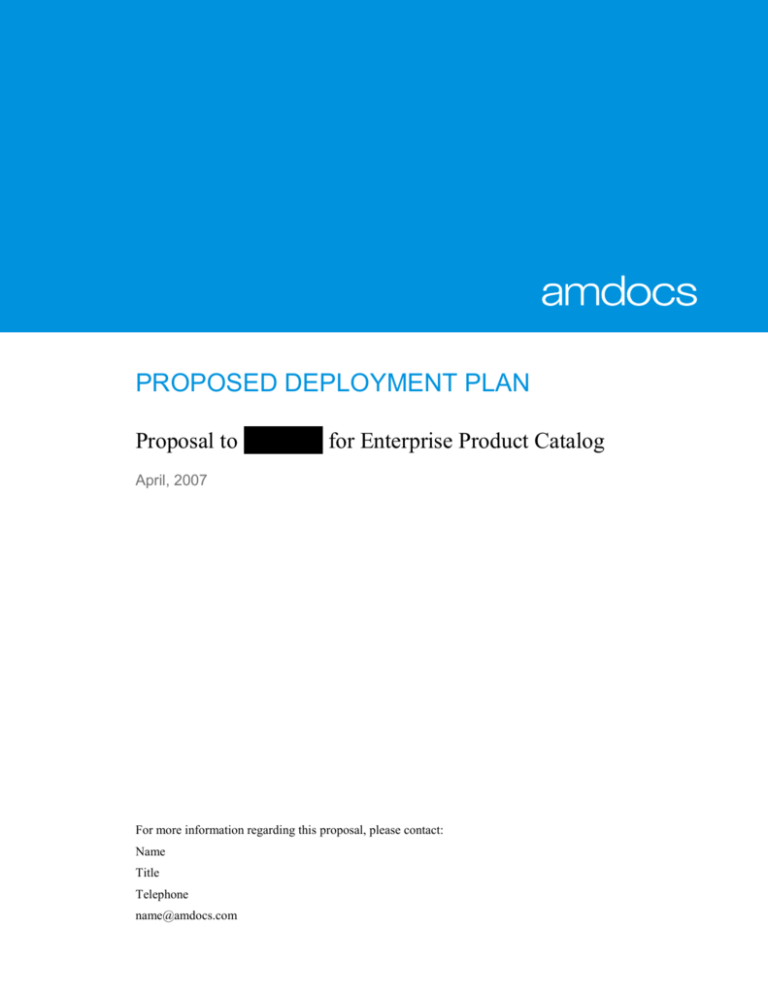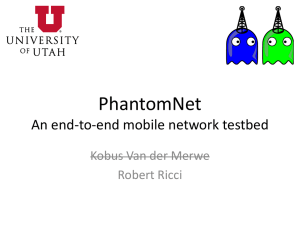
PROPOSED DEPLOYMENT PLAN
Proposal to Comcast for Enterprise Product Catalog
April, 2007
For more information regarding this proposal, please contact:
Name
Title
Telephone
name@amdocs.com
TABLE OF CONTENTS
1.
1.1.
1.2.
INTRODUCTION
Project Scope
Project Timeline
1
1
2
2.
2.1.
EPC DEPLOYMENT APPROACH
Phases
4
4
3.
ASSUMPTIONS
7
4.
4.1.
PHASE 1: DEPLOYMENT SCOPE & DESIGN
Overview
4.1.1. Program Management
4.1.2. Scope Definition
4.1.3. Architecture Design
4.1.4. Requirements Definition
4.1.5. Hardware & Software
4.1.6. Data Model Design
4.1.7. Training
9
9
9
10
10
11
12
12
13
5.
PHASE 2: CONSTRUCTION (CUSTOMIZATION, CONFIGURATION AND
SYSTEM TEST) PHASE
Overview
5.1.1. Construction/Configuration Development
14
14
14
PHASE 3: IMPLEMENTATION (INFRA, UAT, AND FINAL DEPLOYMENT)
Overview
6.1.1. Infra
6.1.2. Acceptance Testing
6.1.3. Deployment Readiness Planning
6.1.4. Pre Deployment Activities
6.1.5. System Deployment and handover
16
16
16
17
17
18
18
5.1.
6.
6.1.
APPENDIX A. PROPOSED EPC DEPLOYMENT WBS
19
© Amdocs 2007. All Rights Reserved. Reproduction or distribution other than for intended purposes is prohibited, without
the prior written consent of Amdocs. These materials are confidential, and shall be returned to Amdocs upon request.
Amdocs® and its other trademarks are the exclusive property of Amdocs, and may not be used without permission. All
other trademarks mentioned in this material are the property of their respective owners.
1.
INTRODUCTION
To support Comcast in implementing an Enterprise Product Catalog solution, Amdocs
proposes the following EPC Deployment Project to define, develop, and deploy the
Amdocs Enterprise Product Catalog (EPC). This deployment plan details the areas to be
covered during the project as well as the groups involved. It covers all critical aspects of
deploying a turn-key EPC solution. The deployment effort concludes upon providing an
EPC product, with constructed templates to support DDP, DDPS, Saville, and CSG,
installed on the designated hardware. The integration effort of the EPC to the downstream
applications is not included in the deployment effort and is fully described in the EPC
Proposed Integration Strategy.
Amdocs Enterprise Product Catalog is a new product specifically designed for the
centralized management of products and propositions across an enterprise in a SOA
environment. Amdocs EPC enables its users to design, build and manage a central
repository for products and services. It employs a graphical user interface (GUI)
application to design and implement a catalog model.
1.1. Project Scope
Amdocs Enterprise Product Catalog acts as a central repository shared between billing,
CRM and content revenue management applications. It also features import and export
capabilities based on industry-standard XML formats, to enable interoperability with
other systems and facilitate integration into service providers’ existing heterogeneous
environment. This EPC Deployment Strategy covers the following:
>
>
>
>
>
>
>
>
Program Management
Analysis of Environment
Definition of Requirements
Design and Implementation of Data Model to Support the Comcast
implementation of EPC
Definition and design of template to support the data model
Definition, configuration, and configuration of the hardware environment
Installation and testing of the EPC
Deployment of the EPC for production
Proprietary and Confidential
Page 1
INTRODUCTION
PROPOSED DEPLOYMENT PLAN
The following diagram shows the elements of the EPC that will be provided in the
deployment. See the Proposed Integration Strategy Document for details of the
integration strategy.
Figure 1: Enterprise Product Catalog
FRONT END
DESIGNER
CATALOG
SERVICES
CATALOG
BROWSING
CATALOG
UPLOADING
RULES
EXECUTION
BACKEND
Security
Manager
PROJECT
MANAGEMENT
IMPORT/
EXPORT
DISTRIBUTION
VALIDATION
HIERARCHIES
AUDITING
ELEMENT
VERSIONING
ELEMENT
OPERATION
USER ROLE
ACCESS
QUERIES
DATA MODEL
TEMPLATES
ELEMENTARY
TYPES
ELEMENTS
ENTERPRISE PRODUCT CATALOG
1.2. Project Timeline
The deployment timeline assumes the project will start on May 1, 2007 and the final
deployment (production) of the EPC modules ready for data conversion with at least one
billing system by November 2007.
Proprietary and Confidential
Page 2
3
Design
4
Construction (customization,
configuration, testing)
5
Infra (Staging, Installation &
Configuration)
23d
117d
165d
INTRODUCTION
UAT (User
Acceptance Testing)
PROPOSED
DEPLOYMENT
PLAN&
6
184d
UAT Suppor
7
Deploy to Production
Q2 07
ID
May
1
Scope
2
Training (Implemetnation/Internal)
3
Design
4
Construction (customization,
configuration, testing)
5
6
7
Q3 07
Q4 07
Task Name
Infra (Staging, Installation &
Configuration)
UAT (User Acceptance Testing) &
UAT Suppor
Jun
Jul
Aug
Sep
Oct
Nov
Dec
30d
35d
23d
117d
165d
184d
Deploy to Production
For a more detailed timeline see the Microsoft Project Plan attached to this document as
an appendix.
Proprietary and Confidential
Page 3
2.
EPC DEPLOYMENT APPROACH
This document details the methods that Amdocs will use to deploy the Amdocs
Enterprise Product Catalog (EPC) at Comcast. Each area of the deployment is reviewed
in the following sections, which outline the goal, and output, a list of activities to be
performed, and the responsible parties for each deployment area.
Amdocs intends to deploy EPC using a phased approach to ensure a complete,
coordinated and successful project delivery to Comcast that aligns with overall business
and quality objectives.
2.1. Phases
The EPC deployment plan consists of three phases:
Analysis and Design Phase:
During this phase scoping, analysis, and design efforts will be carried out by a combined
team of Amdocs business consultants and product professionals, a local on site team, and
Comcast business experts (30% of the team) to lay the foundation for a successful
solution. Required training for the implementation team members will be determined.
Construction Phase
Based on the requirements, Amdocs development teams will develop the EPC data
model, element types, API queries, and templates. Amdocs implementation and testing
teams will design EPC configuration, unit and system testing strategies, and deployment
of a sandbox environment. Comcast team members will validate resulting templates.
Implementation Phase
The implementation phase comprises:
>
>
Acquisition and installation of the hardware and software
Testing
Proprietary and Confidential
Page 4
EPC DEPLOYMENT APPROACH
PROPOSED DEPLOYMENT PLAN
>
>
>
Configuration
UAT D
Deployment into a production environment.
Phase 1: Analysis and Design
Phase 1 of the deployment process includes joint Amdocs and Comcast sessions
dedicated to;
>
>
>
>
Definition of the data model.
Definition of business roles and public roles for the users.
Design of the templates that will be used to create elements in EPC.
Design the test cases that will be used during the acceptance test phase.
Phase 1 represents several additional parallel activities. Amdocs and Comcast PMO
teams will refine the project plans and create the PMO process to control the project.
Infra team sessions will target the definition of hardware (need to buy, leasing, move
from project to project), disk space, scalability, and software.
Phase 2: Construction
At the completion of the Phase 1 activities (and validation of the deliverables) the EPC
project moves into Phase 2 where the development team will work on the data model,
validations, and template creation. The team will present the data model to Comcast
Billing teams (CSG, DDP,DDPF and Saville) and the final mapping between the billing
systems and the EPC data model will be completed
The installation work will be performed in parallel to the development effort, so the final
tasks of Phase 2 overlap with the initial tasks of Phase 3.
Phase 3 Implementation
The Infra team will install, configure and shake out the environment that will be used to
deploy the EPC software. The data model, user security, and templates will be deployed
into the environment and validated to confirm that software and hardware are working
together.
Proprietary and Confidential
Page 5
EPC DEPLOYMENT APPROACH
PROPOSED DEPLOYMENT PLAN
Once the installation is confirmed the software will be tested and necessary adjustments
made. The test cases and scenarios defined by the testing team will be used to confirm the
software.
Proprietary and Confidential
Page 6
3.
ASSUMPTIONS
Amdocs has identified the following critical assumptions affecting this proposed
Deployment Strategy:
Program/Project Management Assumptions
>
>
>
>
>
>
>
>
This deployment plan is describing the activities required from the scoping phase
thru the delivery of an EPC product, populated with templates enabling data entry
required for DDP, DDPF, Saville, and CSG. It does not include activities or tasks
associated with the integration strategy to the downstream applications.
Post-Deployment activities are not part of this document.
Comcast will provide computer hardware and software for Amdocs consultants to
use during the life of the project, at no cost to Amdocs.
Comcast will provide adequate office facilities (desk, phone, computer access and
so on) for each Amdocs consultant while on-site, at no cost to Amdocs.
Comcast to provide Amdocs access to its internal sites and portals, if needed.
Amdocs will have access to Comcast’s subject matter experts regarding Business
Requirements, Systems Architecture, and other areas of information pertinent to
the project related activities.
Amdocs is responsible and accountable for providing overall program and project
management for the proposed project. Amdocs will be responsible for activities
and the project management of these activities assigned to them by Comcast
project manager.
Amdocs personnel will abide by Comcast security and confidentiality policies
when using Comcast facilities, equipment and software.
Development Assumptions
>
The plan includes a specific number of EPC entities, controls, templates, and
validations based on data model to be developed during the requirements phase.
This plan uses the following initial estimates, which may change based upon the
results of the requirements gathering:
> Total of 33 templates for all catalogs
> 30% complex templates; 70% simple templates
> One Control for elementary/reference field per catalog
Proprietary and Confidential
Page 7
ASSUMPTIONS
PROPOSED DEPLOYMENT PLAN
Two Controls for regular element fields per catalog
Two Controls for complex element fields per catalog
Comcast will be responsible for implementing and managing the Aqualogic
services infrastructure. Comcast will configure Weblogic ESB in a fail-over mode
to provide maximum availability.
Amdocs Enterprise Product Catalog will hold service codes (codes that indicate
provisioning instructions to outside systems); however, provisioning will be
accomplished via Comcast Bedrock, or a similar system.
Distribution Manager will be a message driven bean, and be custom development
> External to Amdocs Enterprise Product Catalog
> Input – Amdocs Enterprise Product Catalog Distribution XML (in a zip file)
> Responsible for setting the required data for distribution, mapping the
information to target system, distributing the data to target systems and sends
acknowledgement back to Amdocs Enterprise Product Catalog backend
system
Amdocs Enterprise Product Catalog will be the source for all product catalogs.
Changes made to the master product catalog will be propagated to the down
stream systems.
SOAP/http will be preferred way to communicate between systems. Services will
be developed to abstract the systems and to perform the necessary data mapping.
Amdocs Security Manager will be used for providing security service to EPC
(authentication & authorization).
>
>
>
>
>
>
>
>
Proprietary and Confidential
Page 8
4.
PHASE 1: DEPLOYMENT SCOPE & DESIGN
4.1. Overview
During this phase, Amdocs will work with Comcast to set the project scope and program
management parameters, and will identify high level requirements and designs. We will
conduct detailed Scope Sessions with Comcast to ensure a thorough understanding of the
requirements. This phase includes training of project team resources to ensure that the
required skill sets are in place.
Upon completion of scope sessions and related deliverables, Amdocs will conduct Design
Sessions to ensure all requirements can be translated into the EPC data model. The
sessions will define the basic data model and will be presented by Amdocs to Comcast.
4.1.1.
Program Management
Goal
Program Management seeks to build overall project understanding between the PMOs
team (Comcast and Amdocs) of the project, dependencies, resources, and
communications needs. The PMOs should define the "Report Status" to be published,
escalation process, project sponsors, daily, weekly, bi-weekly and monthly meetings, and
the communications plan.
Output
>
>
>
Final EPC Project Plan agreed by Comcast and Amdocs
EPC Project Roles & Responsibilities
Project Communications Plan
Participants
Amdocs Product Management and Comcast Product Management.
Proprietary and Confidential
Page 9
PHASE 1: DEPLOYMENT SCOPE & DESIGN
PROPOSED DEPLOYMENT PLAN
4.1.2.
Scope Definition
Goal
Define the project scope, roles and responsibilities.
Output
>
Project Scope Document
Participants
Amdocs Product Management and Business consultants, Comcast Representatives with
target system knowledge.
4.1.3.
Architecture Design
Goal
The Architecture Design session will define the final architectural solution for the
implementation of the EPC. This will be also used to define the integration strategy
architecture with other edges and billings systems.
Output
>
>
>
EPC Project Architecture Document
Edge System Impact Analysis Document
EPC Project Overall Integration Document
Participants
Amdocs Product Management and Business consultants, Comcast Representatives with
target system knowledge.
Proprietary and Confidential
Page 10
PHASE 1: DEPLOYMENT SCOPE & DESIGN
PROPOSED DEPLOYMENT PLAN
4.1.4.
Requirements Definition
Goal
The Requirements Definition session(s) will define the solution requirements for the
EPC. In this session Comcast and Amdocs jointly will define:
>
>
>
>
>
>
>
>
>
>
Translation of the Comcast business vision into EPC business requirements.
Requirements necessary to create the EPC basic data model, and validations
EPC Basic Data Model Definition & Design
> Element types
> Data Relationships
Templates for
> DDP
> DDPF
> CSG
> Saville
Data Entry User Interface (UI)
Security User Roles
Data Mapping Services Requirements.
Determine generic output requirements (templates) for downstream systems
> DDP
> DDPF
> CSG
> Saville
API for Query and API for Update (if requested)
Determine Pilot (Sandbox) Deliverable and Exit Criteria
Determine Operational Design Requirements
Output
>
>
>
>
>
EPC Basic Data Model Requirement
EPC Templates Requirements
EPC Basic Data Model x Billing Systems Data Mapping
EPC Security Requirements (users and roles)
Operational Design Requirements
Participants
Amdocs Product Management and Business consultants, Comcast Representatives.
Proprietary and Confidential
Page 11
PHASE 1: DEPLOYMENT SCOPE & DESIGN
PROPOSED DEPLOYMENT PLAN
4.1.5.
Hardware & Software
Goal
Definition of the hardware, software, communication protocols and disk space that will
guarantee that EPC will perform and hold products, offers and needed templates. These
definitions must consider:
>
>
>
>
Hardware for: Testing and Production.
Scalability
Availability and Fail Over
Backup and recovery requirements
Output
>
>
>
>
>
>
Hardware Acquisition list
Software Acquisition list
Roles and Responsibilities related with Hardware and Software
Hardware and Software Acquisition and installation process timeline plan.
Basic Purchase Order to be approved by Comcast
Date for Install Amdocs Enterprise Catalog 7.1
Participants
Amdocs TACT team, Comcast Business Representative, Comcast Infra Representative
Comcast Business representative must have an understanding of how the data
model was created and the impact on the volume of elements (product and price
elements) to be created in EPC.
> Comcast Infra Representative must have the knowledge of the procedures used by
Comcast for data communication, backups, high availability, and overall system
architecture.
>
4.1.6.
Data Model Design
Goal
Based on the requirements from Comcast, Amdocs will present the suggested EPC basic
data model to Comcast. The suggested EPC basic data model will be reviewed by
Comcast and Amdocs. From this session the data model will be updated creating the
concept data model. The concept data model will be used by development team to build
the final data model. The concept data model will be presented to CSG,DDP/DDPF and
Proprietary and Confidential
Page 12
PHASE 1: DEPLOYMENT SCOPE & DESIGN
PROPOSED DEPLOYMENT PLAN
Saville billing analysts to verify mapping between the current product catalogue and
EPC. Based on the mapping results an EPC template for each billing system will be
created as part of the deployment.
Output
>
>
>
Data Model ERD
Concept templates each entity in the ERD
Templates for each Billing System
Participants
Amdocs Product Management and Business consultants, Comcast Representatives with
target system knowledge, Comcast EPC sponsors, billing representing from CSG,
DDP/DDPF and Saville.
4.1.7.
Training
Goal
Increase the knowledge of Comcast team member of EPC.
Output
>
>
Training sessions
Training materials
Participants
Comcast team members. Amdocs will provide set of training materials and trainers, as
required, subject to a separate pricing offer.
Proprietary and Confidential
Page 13
5.
PHASE 2: CONSTRUCTION (CUSTOMIZATION,
CONFIGURATION AND SYSTEM TEST) PHASE
5.1. Overview
During this phase, Amdocs will construct the element types, templates, API queries, and
EPC data model according to the designs completed and approved in Phase 1. Upon
construction completion, the testing team will be performing testing activities where the
requirements, EPC software, operational requirements, templates and data model will be
validated within the EPC. This team will create the necessary test cases, mitigation
procedures, scenarios and exit and entrance criteria for each step. We will also establish
the Pilot environment and deliver a minimum of one template to this environment to
allow the Comcast implementation team to begin familiarizing themselves with
procedures, business rules and components of the EPC.
5.1.1.
Construction/Configuration Development
Goal
Using the requirements, detailed designs, data models, and data maps from the joint
Scope and Design sessions, Amdocs will develop, configure and test code for the
Amdocs Enterprise Product Catalog templates UI and EPC Distribution Client.
Specifically, the components to be developed, tested, and configured are:
Data Model
> Define entity types
> Define entity structure
> Define entities
> Define entity relationships
> Templates
> DDP
> DDPF
> CSG
> Saville
> Validations Definition & Design
> Business Rules
>
Proprietary and Confidential
Page 14
PHASE 2: CONSTRUCTION (CUSTOMIZATION, CONFIGURATION AND SYSTEM TEST) PHASE
PROPOSED DEPLOYMENT PLAN
>
>
>
>
Interface Development
EPC Configuration
EPC Users configuration and access definition
EPC Hierarchy Configuration
Output
An Amdocs Enterprise Catalog solution that meets the detail designs determined jointly
by Amdocs and Comcast and is ready to be configured and tested.
Participants
Amdocs Product Management and Amdocs Development
Proprietary and Confidential
Page 15
6.
PHASE 3: IMPLEMENTATION (INFRA, UAT, AND
FINAL DEPLOYMENT)
6.1. Overview
During this phase, Amdocs will perform Infra activities to stage, install and configure the
solution. Amdocs and Comcast testing teams will execute all test cases created in the
previous session. Both teams will monitor the test results and take appropriate actions on
defects discovered. The PMO function will publish the "Test Status", Risks and
Mitigation.
The Amdocs and Comcast teams that participated in the requirement session and
development phases will support the UAT. The PMO will be responsible for defining the
resource plan for support.
6.1.1.
Infra
Goal
Infra Staging activities encompass purchasing and licensing of agreed upon Hardware
and Software and set up in the deployment (production environment) according to the
operational design. We will also install hardware, third-party software and components of
the EPC solution, configure it and perform shake out activities to ensure readiness for
UAT.
Outputs
>
Properly configured, stable UAT environment
Participants
Amdocs Testing and Implementation teams and Comcast Testing team.
Proprietary and Confidential
Page 16
PHASE 3: IMPLEMENTATION (INFRA, UAT, AND FINAL DEPLOYMENT)
PROPOSED DEPLOYMENT PLAN
6.1.2.
Acceptance Testing
Goal
Plan the UAT testing operations and schedule, including technical and management
topics (such as scope, testing approach, tools, risks, resources, relations with the
customer, etc.) that will be used as the basis for designing subsequent testing activities.
Define entrance and exit criteria for each step in the test process. Create the calendars and
test cases that meet the customer's requirements and system requirements by creating the
test scenarios
Output
Testing Approach document
Tools definition to be used during test
Risk table and mitigations
Resource plan for testing
Test cases and business scenarios (product, price and offer defined using EPC
modules)
> Regression calendars
> Testing Summary
>
>
>
>
>
Participants
Amdocs Testing team and Comcast Testing team.
6.1.3.
Deployment Readiness Planning
Goal
Plan all activities that need to be completed prior to and during deployment of EPC.
Output
>
>
>
>
>
>
Business Readiness Checklist
Business Readiness Audit Parameters
Communication Plan
Escalation Procedures
Issue Management and Tracking
Post Deployment Support Plan
Proprietary and Confidential
Page 17
PHASE 3: IMPLEMENTATION (INFRA, UAT, AND FINAL DEPLOYMENT)
PROPOSED DEPLOYMENT PLAN
>
Command Center Plan
Participants
Amdocs PMO and Delivery team, Comcast project representatives.
6.1.4.
Pre Deployment Activities
Goal
To perform all identified activities that will facilitate the successful rollout of the EPC
solution to the Comcast production environment.
>
>
>
Perform Readiness Checklist items
Perform Readiness Audit
Deploy Communication Plan
Output
Environments, EPC solution, and Comcast business ready to deploy the application.
Participants
Amdocs Infra, Business Configuration, Project Management, and Product Management
teams. Comcast Project Representatives.
6.1.5.
System Deployment and handover
Goal
Final handover of a properly configured, fully functional EPC solution ready for live
production.
Proprietary and Confidential
Page 18
APPENDIX A. PROPOSED EPC DEPLOYMENT WBS
Microsoft Project
Plan
Proprietary and Confidential
Page 19








